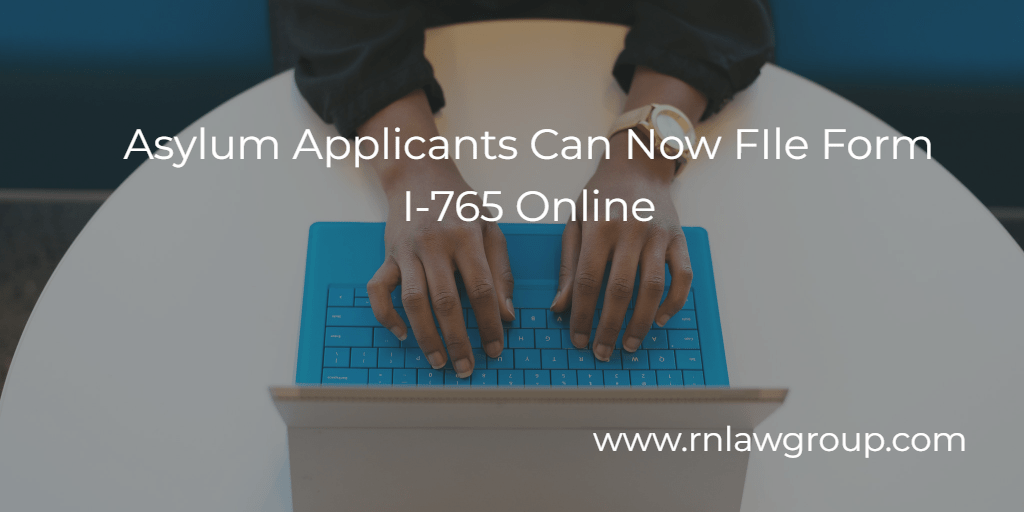
Asylum Applicants Can Now FIle Form I-765 Online
The United States Citizenship and Immigration Services announced that certain asylum applicants can now file Form I-765 Application for Employment Authorization online. Applicants for employment authorization under category (c)(8), Pending Asylum and Withholding of Removal Applicants and Applicants for Pending Asylum under the ABC Settlement Agreement, may file Form I-765 online.
To apply for an Employment Authorization Document (EAD) based on a pending asylum application under the (c)(8) eligibility category, applicants may file the Form I-765 150 days after they file their asylum application. Applicants are not eligible to receive an EAD until their asylum application has been pending for at least another 30 days, for a total of 180 days, commonly referred to as the 180-Day Asylum EAD clock. The filing date is the date USCIS receives a properly filed Form I-589, Application for Asylum and for Withholding of Removal, and can be found on an applicant’s receipt notice. Please note that USCIS is currently experiencing delays in issuing receipt notices for Form I-589, Application for Asylum and for Withholding of Removal, so applicants may not receive their receipt notice in a timely manner after filing the Form I-589. If an applicant’s receipt notice has been delayed, the filing date can be determined by the I-589 delivery date.
In order to file the Form I-765 online, applicants must first create a USCIS online account at my.uscis.gov. A USCIS account is free to create and offers a variety of features, such as the ability to communicate with USCIS concerning applications through a secure inbox, tools to aid applicants in the process of filing their petition, and information to help explore immigration options. If an applicant has previously filed a USCIS form online, they may use their existing USCIS online account to file the Form I-765.
At this time only certain categories of I-765 applicants are eligible for online filing, including (a)(12) Temporary Protected Status granted; (c)(3)(A) F-1 Student, pre-completion Optional Practical Training; (c)(3)(B) F-1 Student, post-completion Optional Practical Training; (c)(3)(C) F-1 Student, 24-month extension for science, technology, engineering and mathematics (STEM) students; (c)(8) Asylum application pending for a minimum of 150 days; (c)(11) Paroled for urgent humanitarian or significant public benefits purposes; and (c)(19) Certain pending TPS applicants whom USCIS has determined are prima facie eligible for TPS and who may then receive an EAD as a “temporary treatment benefits” under 8 C.F.R. 244.10(a). If applicants submit the Form I-765 online but are not filing under an eligible employment authorization category, USCIS may deny the application without refunding the fee.
While there are many benefits to filing the I-765 petition online, applicants who file a paper Form I-765, or any other USCIS form, can still create an online account to track the status of their form throughout the adjudication process.
What is Asylum?
Asylum is a protection granted to foreign nationals already in the United States or arriving at the border who meet the international law definition of a “refugee.” A refugee is a person who is unable or unwilling to return to their home country, and cannot obtain protection in that country, due to past persecution or a well-founded fear of being persecuted in the future on account of race, religion, nationality, membership in a particular social group, or political opinion. An asylee is a person who meets the definition of refugee and is already present in the United States or is seeking admission at a port of entry. Asylum is a discretionary status, meaning that some individuals can be denied asylum, even if they meet the definition of a refugee. For those individuals, another form of protection known as “withholding of removal” may be available to protect them from harm if necessary.
An asylee, or a person granted asylum, is protected from being returned to their home country, is authorized to work in the United States, may apply for a Social Security card, may request permission to travel overseas, and can petition to bring family members to the United States. Asylees may also be eligible for certain government programs. After one year, an asylee may apply for lawful permanent residence status (i.e., a green card). After the individual becomes a permanent resident, they must wait four years to apply for citizenship.
How to Apply for Asylum
Generally, any foreign national physically present in the United States or arriving at a POE may seek asylum regardless of immigration status. Those seeking asylum must apply within 1 year from the date of last arrival or must establish that an exception applies based on changed or extraordinary circumstances. For example, unaccompanied noncitizen children are not subject to the 1-year filing deadline.
There are three primary ways in which a principal applicant may obtain asylum: affirmatively through a USCIS asylum officer, defensively in removal proceedings before an immigration judge of the Department of Justice’s Executive Office for Immigration Review (EOIR), or through an asylum merits interview with USCIS after a positive credible fear determination. Each process differs and not all require the filing of the Form I-589.
|
Affirmative Asylum Processing with USCIS |
Defensive Asylum Processing with EOIR |
Asylum Merits Interview with USCIS After a Positive Credible Fear Determination (i.e., Expedited Removal) |
|
Applicant has not been placed in removal proceedings before an immigration judge (unless they are an unaccompanied child). |
Applicant has been placed in removal proceedings before an immigration judge. |
Applicant is subject to expedited removal and found to have a credible fear of persecution or torture.
Applicant has not been placed in removal proceedings before an immigration judge.
|
|
Applicant submits Form I-589 |
Applicant is: 1. Placed in removal proceedings by USCIS after USCIS does not grant asylum in the affirmative process; 2. Placed in removal proceedings by ICE or CBP for immigration violations; or 3. Subject to expedited removal, found to have a credible fear of persecution or torture, and issued a Notice to Appear.
If the applicant was referred to EOIR by USCIS, the asylum application on file with USCIS will carry over to the immigration judge, provided it was not abandoned or dismissed. If the applicant does not have an asylum application on file with USCIS, the applicant must submit a Form I-589 to the immigration judge if they wish to apply for asylum.
|
The written record of the positive credible fear determination made during the credible fear screening process is treated as the application for asylum.
Applicant does NOT need to file a Form I-589 with USCIS. |
|
Applicant appears before a USCIS asylum officer for a non-adversarial affirmative asylum interview. |
Applicant appears before an immigration judge with EOIR for an adversarial, court-like hearing, if necessary. |
Applicant appeared for a credible fear screening interview with a USCIS asylum officer. Applicant was found to have a credible fear of persecution or torture and USCIS retained the case.
An asylum officer further considers the application for asylum in a non-adversarial Asylum Merits interview. If they do not grant asylum, they will determine the applicants eligibility for withholding of removal or protection under the Convention Against Torture (CAT) based on the record before USCIS.
|
|
Applicant usually must provide a qualified interpreter for the affirmative asylum interview. |
The immigration court provides a qualified interpreter for the asylum hearing and all other court proceedings.
|
USCIS provides a qualified interpreter for the Asylum Merits Interview. |
As of November 15, 2022, affirmative asylum applicants can file the Form I-589 online
How to Bring Family to the United States
Spouses and unmarried children under the age of 21 who are not included in the principal’s grant of asylum may obtain derivative asylum status by filing the Form I-730. There is no fee to file this petition. A principal asylee may petition for follow-to-join benefits for qualifying derivatives within 2 years after they were granted asylum, as long as the relationship between the principal and their spouse and/or child existed on the date the principal was granted asylum.
For more information concerning asylum and how to navigate this process, please contact one of our qualified immigration attorneys.
Reddy Neumann Brown PC has been serving the business community for over 20 years and is Houston’s largest immigration law firm focused solely on US. employment-based immigration. We work with both employers and their employees, helping them navigate the immigration process quickly and cost-effectively.
By: Ashley Thomas
Ashley Thomas is an Senior Associate Attorney at Reddy Neumann Brown PC who focuses on employment-based non-immigrant visas. Ashley’s practice covers all phases of the visa process including filing petitions, responding to Requests for Evidence (RFE), and drafting motions and appeals. She has completed over 200 RFE’s to date in response to H-1B, L-1, I-140, and OPT petitions.

